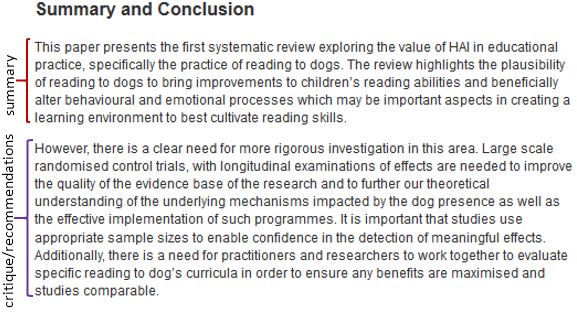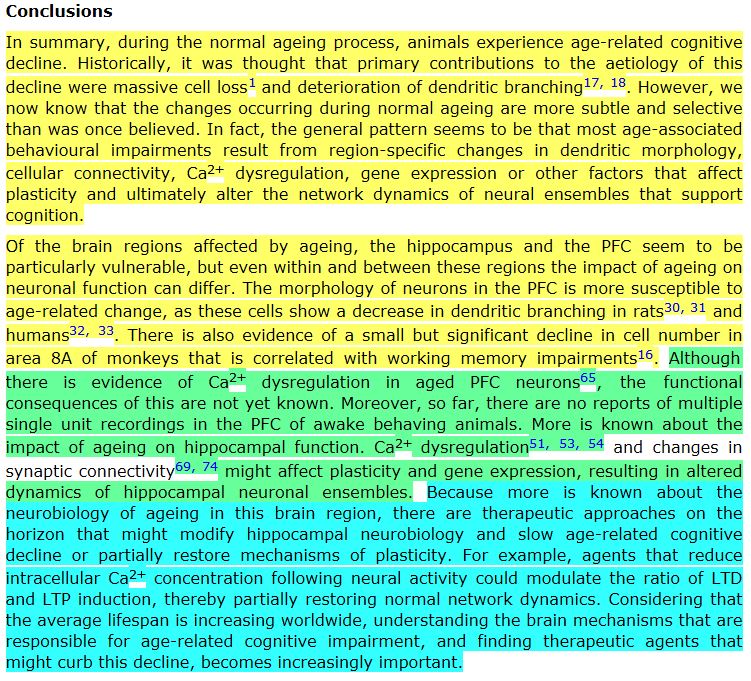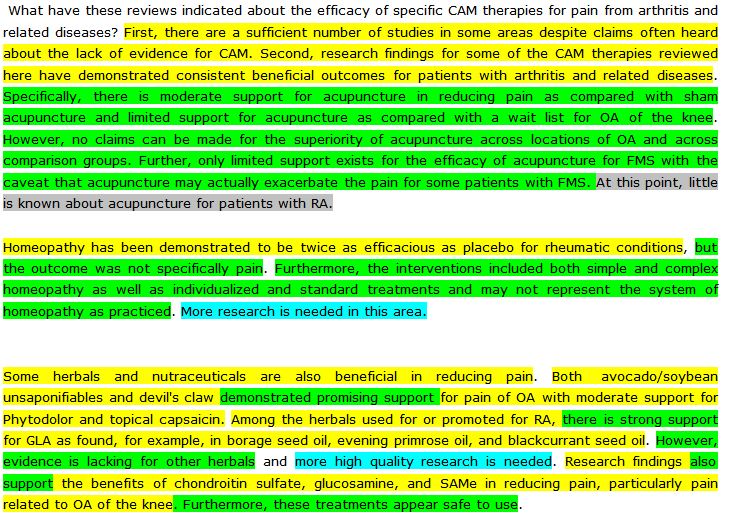 Recall from the initial discussion of Review papers that these publications make two kinds of contribution: 1) an organized synthesis of the current state of an area of research according to a (novel) perspective; 2) critical commentary from the writer who eventually recommends directions for further research and/or application.
Recall from the initial discussion of Review papers that these publications make two kinds of contribution: 1) an organized synthesis of the current state of an area of research according to a (novel) perspective; 2) critical commentary from the writer who eventually recommends directions for further research and/or application.
In a review paper, the conclusion is a short, bottom-line piece of writing. First, the conclusion offers a brief summary of the main ideas of each topic subsection (generally, only a single sentence or so per MAIN subheaded section) – this is the summary function of a conclusion. Second, assuming that critique is NOT in the body of the paper, you’ll write the critique. This is an important step for the reader: they’ve just read your synthesis, and now would like to know what you think about all the work you’ve done! Much like a research report, the reader wants to know how the reviewed information impacts the field. This is what your critique helps provide.
 Finally, the review conclusion ends with
Finally, the review conclusion ends with
your recommendations based on the reviewed research and critique — what should happen next? Be as targeted as you can here, but do not make suggestions outside the constraints of the perspective you stated in the introduction. For example, if you reviewed the efficacy of a particular activity in terms of its economic impact, you need to make recommendations related to that idea. You’ll also find that recommendations for future research can be quite generic, e.g. “This area merits further investigation”.
Thus, your conclusion will depend partly on the decisions made about critique. If critical evaluation is provided in the body of the paper, it need not be repeated in the conclusion, though it should be summarized. If critical evaluation is not provided in the body of the paper, then it must be provided in the conclusion.
There are two ways of furnishing critical commentary.
- First, critique may be provided at the end of each topical subsection. Sometimes, recommendations are also provided, especially if the Review is particularly complex.
- If critique in included in the body of the paper, then you may add a short summary of the critique to the conclusion. This is not required, and depends on the length and complexity of the paper; the longer and harder it is to read, the more likely the author is to include a summary of the critique in the conclusion
- Second, all critique/recommendations are saved for the conclusion.
Which is the best pattern? As always, consider the reader. The more complicated the reading task, the more difficult it is for the reader to absorb the writer’s message. If the topical subsections are fairly straightforward, with little controversy/conflict involved, then it’s okay to save all critique/recommendations for the end of the paper. Many published review papers save the critique until the end, in the concluding section of the paper.
Often, the topics are not so straightforward. In that case, it is easier for the reader (and also for the writer) to finish each section with the writer’s critical evaluation of the material. In this manner, each topical subsection reads like a fairly complete mini-essay; the reader can pause, grab a cup of coffee and a Snickers, and return to the review without sacrificing comprehension. Note that all critical evaluation comes at the END of a subsection. If you find yourself logically needing to provide some critique before continuing on within a particular section, then you need to create a second-level subsection (a subtopic within your main topic subsection – for the visual thinkers, these are the child nodes connections coming off a main/parent node). Keep in mind: the prime directive here is that all critical evaluation is written in a separate paragraph at the end of a section.
Critique in Body/Summary and Recs in Conclusion
The example below shows critique included in the body of the review, in its own paragraph at the end of the subsection. The conclusion to the review provides a very brief mention.
Writing Tip: Remember that writing in the sciences features writing in blocks of information defined primarily by paragraph boundaries.
Example (body section) || A comprehensive review of full cost accounting methods and their applicability to the automotive industry
5.3.5. Sustainable value (SV) concept
Figge and Hahn (2004) developed a valuation methodology which allows an estimation of the cost of sustainability capital and the sustainable value created by a company. The concept has been applied mainly in the oil and gas and automotive industries (see Figge and Hahn, 2005 and Figge et al., 2008). The capital and value added approach is not a new concept and it was previously adapted by Atkinson (2000) in a corporate genuine saving (CGS) rate. The idea behind CGS is that a company should adjust its net profit (value added) to the environmental damage caused by its activities and eventually receive a green value added indicator. The innovation in the SV concept is that it integrates other forms of capital (social and financial) with the use of natural capital and applies traditional market valuation techniques (opportunity cost) to evaluate the use of all forms of capital (Figge and Hahn, 2005). Opportunity cost has been mainly applied in the valuation and allocation of economic capital. The authors of SV took this concept forward and employed it to estimate the value of environmental and social capital.
The main limitation of the SV concept is that it includes only nine indicators to assess sustainability of an organisation (one economic, six environmental and two social), which can be partly explained by the algorithm used for calculating the value added of each capital. One of the principles behind estimating SV is to calculate the efficiency of resources used by the company and its benchmark. The benchmark is usually represented by the weighted average of the whole industry in which the company operates. Hence, the SV calculations rely heavily on figures reported by other organisations. Therefore, the SV assessment is only as comprehensive as the data published by competitors in the industry.
Analysis: The paragraph in blue synthesizes the principal ideas (accounting concept focused on sustainability). Two researchers, Figge and Hahn, are clearly associated with the SV concept. The orange paragraph offers critique, signaled by the words “main limitation”. The paragraph finishes with the impact of the limitation.
Below, the “SV concept” gets very short mention as one of the methods examined; and that is all! The critique itself is not summarized.
7. Conclusions
This paper provides helpful clues for researchers interested in exploring full cost accounting by reviewing, analysing and synthesising the broad range of relevant sources from diverse fields in this topic area. A comprehensive literature review of 4381 papers related to FCA methods was undertaken. It used a systematic approach to extract ten important FCA methods and these were: the SAM, FFF’s sustainability accounting, monetised LCA, SV concept, E P&LA, extended LCC, CWRT, Ontario Hydro, ExternE and USEPA’s method. Based on a careful examination and critical analysis of each approach and existing automotive sustainability measures, the SAM developed by British Petroleum and Aberdeen University has been proposed as a well-developed and potentially practical tool for application in an automotive setting. The SAM can be used by both academics and practitioners to translate a range of conflicting sustainability information into a monetary unit score. This is an effective way of communicating trade-offs and outcomes for complex and multi-disciplinary sustainability decisions in the automotive sector. Its measurement of a broad range of economic, environmental, resource and social effects (both internal and external) is currently lacking within the automotive industry. Its other strengths are the ability to provide monetary metrics together with physical metrics for sustainability assessment, its flexibility and the ability to combine multiple sustainability dimensions.
The original SAM was developed for the oil and gas industry; therefore, applying this method in the automotive context will require the development of a new set of assessment criteria. Both Volvo’s EPS and Ford’s PSI methods do not offer complete coverage of the sustainability metrics. Consequently, future research should focus on developing a framework for the automotive SAM that will contain a comprehensive and complete coverage of impact categories for the sustainability assessment of an automobile. Assessment criteria mentioned in this paper (such as recyclable and non-recyclable materials, vehicle life cycle energy and water consumed, all the forms of air, water and soil pollution, gross profit, safety, mobility, noise, vibration, vehicle interior air quality, human health impacts from the external air quality and employment) are only proposals and cannot be considered as complete and exhaustive. The people who developed the original SAM suggest that sustainability metrics should be developed with the assistance of experts. Hence, specialists (both academics and practitioners) in the automotive industry should be consulted to refine and select sustainability assessment criteria which can be used as a framework for the construction of the automotive SAM.
Analysis: The green sentences embody the summary of the entire paper! Because the bulk of the work is done in the body of the review, Concluding sections are quite succinct. The blue section is the overall critique being offered based on the entire review: after analysis, this is the accounting method they recommend. The orange section explains the work that should come next following the recommendation — primarily, a research agenda that should include both academics and specialists (practitioners) in the industry.
Summary, Critique, and Recs in Conclusion
There are two organizational paths for this option. First, each information move happens in its own block (summary, then critique, then recommendations). Second, the conclusion follows the order of the major subsections of the paper; for each subsection, summary comes first, then critique, finishing with recommendations.
Legend — Yellow: Summary Green: Critique Blue: Recommendations
Example || Mechanisms and Targets of Deep Brain Stimulation in Movement Disorders

Example || Selected CAM therapies for arthritis-related pain: the evidence from systematic reviews
